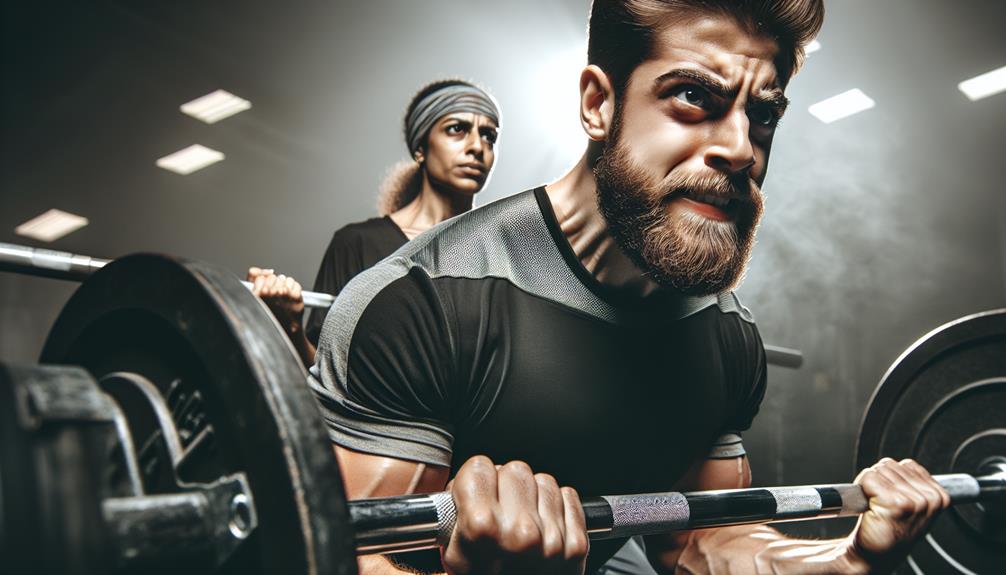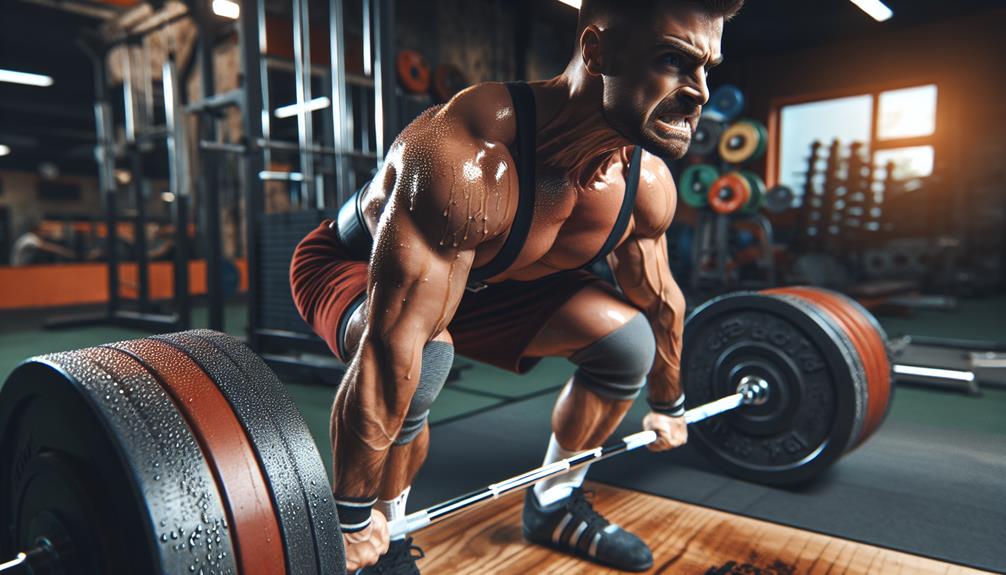In the realm of powerlifting, where strength and performance reign supreme, finding the optimal training split can be likened to unlocking a treasure trove of gains. But with the myriad of options available, how do you navigate through the maze of training methodologies and choose the one that will propel you towards your maximum potential? Fear not, for within the realm of training split variations lies the key to unlocking the true powerlifter within you. From specialized muscle group training splits to full body variations, each approach offers its own unique advantages and benefits. So, whether you're seeking to enhance your upper body strength, develop explosive lower body power, or strike the perfect balance between pushing and pulling movements, prepare to embark on a journey that will revolutionize your powerlifting game.
Key Takeaways
- Different training split variations target specific muscle groups and allow for maximum muscle activation.
- Training splits prevent overtraining and enhance recovery, leading to increased training efficiency.
- Common training splits include upper/lower split, push/pull/legs split, full body split, body part split, and powerlifting-specific split.
- Strategies for maximizing powerlifting gains include prioritizing compound lifts, incorporating variations, using progressive overload, focusing on proper technique and form, and implementing periodization.
Upper Body Training Split Variations

To maximize your powerlifting gains, incorporating upper body training split variations can be an effective strategy. When it comes to building a strong and powerful upper body, two key areas to focus on are bench press variations and shoulder training techniques.
Bench press variations play a crucial role in developing overall upper body strength. The traditional flat bench press targets the chest, shoulders, and triceps, but incorporating variations such as the incline bench press and decline bench press can help to target specific muscle groups more effectively. The incline bench press places more emphasis on the upper chest and shoulders, while the decline bench press targets the lower chest and triceps. By incorporating these variations into your training split, you can ensure that you are hitting all the necessary muscle groups for optimal strength gains.
In addition to bench press variations, incorporating shoulder training techniques is essential for a well-rounded upper body. Exercises such as shoulder presses, lateral raises, and upright rows specifically target the deltoid muscles, which are responsible for shoulder stability and overall upper body strength. It is important to use proper form and technique when performing these exercises to prevent injury and maximize results.
Lower Body Training Split Variations
Incorporate lower body training split variations to maximize your powerlifting gains. To develop a stronger lower body, it is crucial to include a variety of squat variations in your training routine. Squats target multiple muscle groups, including the quadriceps, hamstrings, glutes, and calves. By incorporating different squat variations such as back squats, front squats, and box squats, you can effectively challenge these muscles from different angles and intensities.
Back squats are a staple in powerlifting training as they allow you to lift heavier loads and target the posterior chain. Front squats, on the other hand, shift the emphasis to the quadriceps and core stability. Box squats, where you sit back onto a box before standing up, can help improve your squat technique and explosiveness.
In addition to squat variations, deadlifts are another essential exercise for maximizing your powerlifting gains. Deadlift variations such as conventional deadlifts, sumo deadlifts, and Romanian deadlifts allow you to target different muscle groups and improve strength and power.
Incorporating these squat and deadlift variations into your lower body training split will not only help you build a stronger lower body but also enhance your overall powerlifting performance. Remember to progressively overload, maintain proper form, and listen to your body to ensure safe and effective training.
Push and Pull Training Split Variations

Maximize your powerlifting gains by incorporating various push and pull training split variations. These variations allow you to target different muscle groups, enhance your strength, and optimize your overall performance. When designing your push and pull training split, it is important to consider the use of compound and isolation exercises.
- Compound exercises involve multiple muscle groups and joints, providing a more efficient and functional movement pattern. Examples include bench press, overhead press, deadlift, and row.
- Isolation exercises target specific muscles, allowing for greater muscle activation and hypertrophy. Examples include bicep curls, tricep extensions, lateral raises, and face pulls.
- Programming considerations for push and pull training split variations:
- Ensure a balanced distribution of push and pull exercises to prevent muscle imbalances and reduce the risk of injuries.
- Incorporate progressive overload by gradually increasing the weight or intensity of your lifts over time.
- Allow sufficient recovery time between push and pull training sessions to optimize muscle growth and prevent overtraining.
- Periodize your training by varying the volume and intensity throughout your training cycle to prevent plateau and promote continuous progress.
Full Body Training Split Variations
When implementing full body training split variations, it is crucial to consider the specific needs and goals of the individual trainee. Full body training splits have become increasingly popular among powerlifters due to their ability to maximize strength gains and overall performance.
One of the key benefits of full body training for powerlifting is the increased frequency of training each muscle group. By targeting all major muscle groups in a single session, you can stimulate optimal muscle growth and enhance overall strength. This approach also allows for better coordination and motor unit recruitment, leading to improved performance in compound lifts.
To structure a full body training split for maximum strength gains, it is important to focus on compound exercises that engage multiple muscle groups simultaneously. Start your session with the big three powerlifting movements: squats, deadlifts, and bench press. These exercises target the major muscle groups in your lower and upper body, providing a solid foundation for strength development.
After the main lifts, incorporate accessory exercises that target specific muscle groups, such as lunges, rows, and shoulder presses. Aim for 3-4 sets of 8-10 reps for each exercise, focusing on progressive overload to continually challenge your muscles and promote strength gains.
Remember to prioritize rest and recovery between training sessions to allow your muscles to repair and grow. Implementing full body training split variations with proper structure and intensity can lead to significant improvements in powerlifting performance.
Specialized Muscle Group Training Split Variations

To optimize your powerlifting gains, consider implementing specialized muscle group training split variations. These variations focus on targeting specific muscle groups in your training routine, allowing you to develop strength and size in those areas. Incorporating isolation exercises in specialized muscle group training splits brings several benefits:
- Increased muscle activation: Isolation exercises enable you to isolate and target specific muscles, ensuring maximum activation and development.
- Enhanced muscle symmetry: By focusing on specific muscle groups, you can address any imbalances and create a more symmetrical physique.
- Improved muscle definition: Isolation exercises help to increase muscle definition by targeting specific muscles and enhancing muscle separation.
Designing a personalized training split for specialized muscle group training involves a few key steps:
- Identify your goals: Determine which muscle groups you want to prioritize based on your individual goals and weaknesses.
- Divide your training days: Divide your training days based on the muscle groups you want to target, ensuring adequate rest and recovery between workouts.
- Choose appropriate exercises: Select exercises that specifically target the chosen muscle groups, focusing on isolation exercises that maximize muscle activation.
- Consider volume and intensity: Adjust the volume and intensity of your workouts based on your training experience and recovery capacity.
Frequently Asked Questions
How Many Days per Week Should I Train Each Muscle Group for Maximum Powerlifting Gains?
To achieve maximum powerlifting gains, it is recommended that you train each muscle group 2-3 times per week. This frequency allows for muscle recovery and growth, while also providing the benefits of muscle group specialization.
What Is the Recommended Rest Period Between Sets for Powerlifting Training?
To maximize powerlifting gains, it's important to have proper rest periods between sets. This allows for sufficient recovery and optimal performance. Aim for 2-5 minutes of rest, depending on the intensity and duration of your training.
Are There Any Specific Nutrition Guidelines to Follow for Powerlifting Training?
To maximize your powerlifting gains, it's crucial to follow specific nutrition guidelines and dietary recommendations. These will fuel your body, optimize performance, and support muscle growth. Proper nutrition is an essential component of successful powerlifting training.
Can I Incorporate Cardiovascular Exercise Into My Powerlifting Training Routine?
You can incorporate cardiovascular exercise into your powerlifting training routine. It offers several benefits like improved endurance and recovery. To balance it with strength training, schedule cardio on separate days or after lifting sessions.
What Is the Optimal Number of Repetitions and Sets for Each Exercise in a Powerlifting Training Split?
To maximize powerlifting gains, the optimal number of repetitions and sets for each exercise in your training split depends on your goals. Incorporating progressive overload techniques and working within optimal rep ranges will help you achieve maximum results.
Conclusion
In the realm of powerlifting, the key to unlocking maximum gains lies in the variations of training splits. By strategically dividing your upper and lower body workouts, incorporating push and pull exercises, or engaging in full body or specialized muscle group training splits, you can enhance your powerlifting performance. Just as a sculptor carefully molds their masterpiece, these training split variations allow you to sculpt your physique, chiseling away at your goals with precision and determination. So, embrace the power of variation and unleash your true powerlifting potential.













